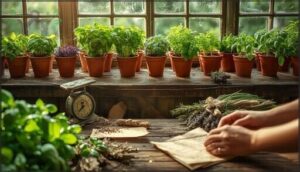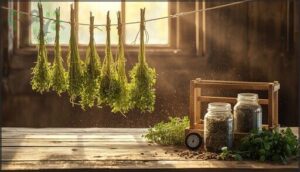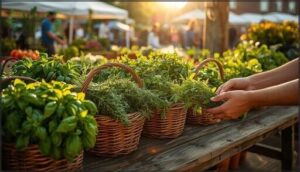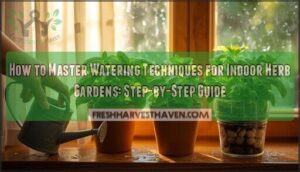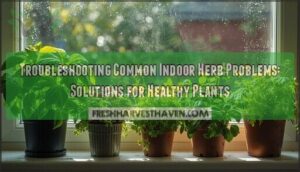This site is supported by our readers. We may earn a commission, at no cost to you, if you purchase through links.
You can turn a quarter-acre plot into a $30,000-per-year business by growing herbs, and you won’t need a tractor or a degree in agriculture to do it. Small-scale herb farming offers one of the lowest barriers to entry in agriculture, with startup costs that can run as little as a few hundred dollars if you’re resourceful.
Fresh basil fetches $16 per pound at farmers’ markets, while dried culinary blends can command even higher prices, and the best part is that herbs grow quickly—you can harvest basil every few weeks during the growing season.
The demand keeps climbing as more consumers seek organic, locally-grown ingredients for their kitchens and wellness routines. Whether you’ve got a backyard, a rented field, or a small greenhouse, you can build a profitable herb operation that fits your available space, time, and goals.
Table Of Contents
- Key Takeaways
- Key Benefits of Small Scale Herb Farming
- Choosing Profitable Herbs to Grow
- Planning and Setting Up Your Herb Farm
- Effective Herb Cultivation Methods
- Harvesting, Processing, and Packaging Herbs
- Marketing and Selling Your Herbs
- Maximizing Profit and Scaling Your Herb Business
- Frequently Asked Questions (FAQs)
- Conclusion
Key Takeaways
- You can start a profitable herb farm on as little as a quarter-acre, with startup costs low enough for most budgets.
- Herbs like basil, cilantro, and lavender are in high demand for culinary, wellness, and medicinal uses, driving strong market growth.
- Sustainable practices such as drip irrigation and composting help you save resources and improve soil health while farming organically.
- Selling directly at farmers’ markets, online, or to local restaurants builds customer loyalty and boosts your income beyond wholesale prices.
Key Benefits of Small Scale Herb Farming
If you’re thinking about starting a small herb farm, you’re entering a business that offers some real advantages over other agricultural ventures. From low barriers to entry to growing consumer interest in natural products, herb farming checks a lot of boxes for aspiring growers.
Let’s look at three key benefits that make this type of farming particularly appealing for small-scale operations.
High Market Demand for Herbs
When you look at where the herb market is headed, the opportunities are hard to ignore. Fresh herb trends and culinary herb demand are climbing fast, while medicinal herb growth shows how consumers value natural wellness. Here’s what makes the herb market demand so strong:
- Global fresh herbs could hit $10 billion by 2030, growing around 9% yearly
- Dried herb expansion is pushing the market toward $4 billion by 2034
- Medicinal herbs are forecast to reach $477 billion by 2032
- Export market potential in Asia-Pacific alone accounts for nearly half of organic herb sales
That profitability isn’t just talk—it’s backed by real numbers. The increasing preference for traditional medicine systems is a major driver for this growth.
Understanding your target market for herbs and marketing your herb business effectively means you’re not just growing plants; you’re tapping into a wellness boom that restaurants, retailers, and health brands all depend on.
Low Startup Costs and Barriers
The financial risk reduction in starting an herb farming business is one of its most appealing features. You don’t need deep pockets or years of savings to launch. Research shows you can begin on plots as small as 1,000–2,000 square feet—less than 5% of an acre—while the typical U.S. farm averages 445 acres.
Land access costs drop dramatically when you use backyard space, community gardens, or lease incubator plots for $100–$500 monthly instead of buying farmland outright at $3,160+ per acre. Infrastructure flexibility means you can skip expensive greenhouses and start with raised beds or containers. Regulatory fees for small-scale operations run just $100–$1,500, far below heavily regulated sectors. Even marginal land can work if drainage is adequate. Starting an herb farm also involves initial inventory costs for supplies.
Here’s how startup costs for herb farming break down for a small business focused on small-scale herb farming:
| Cost Category | Budget Range | What It Covers |
|---|---|---|
| Land & Space | $0–$500/month | Backyard plots, community gardens, or leased incubator space |
| Initial Tool Costs | $500–$3,000 | Hand tools, soil amendments, seeds, basic irrigation supplies |
| Infrastructure | $500–$3,000 | Raised beds, containers, or simple hoop houses for season extension |
Starting small lets you test markets and scale up as revenue stabilizes, rather than betting everything upfront.
Sustainable and Eco-Friendly Practices
Beyond keeping costs in check, small-scale herb farming lets you farm in ways that actually help the planet. Drip irrigation cuts water use by up to 60%, while compost-based organic methods boost soil health and slash climate impact by roughly 56% compared to conventional systems.
Small-scale herb farming uses drip irrigation and compost-based organics to cut water use and climate impact while improving soil health
You’ll support biodiversity, reduce chemical reliance through IPM strategies, and grow organic herbs using sustainable agriculture practices that build resilience into every harvest.
Choosing Profitable Herbs to Grow
Choosing the right herbs to grow can make or break your farm’s profitability, so it’s worth taking time to understand what sells well and fits your growing conditions.
Some herbs are kitchen staples that restaurants and home cooks buy year-round, while others have strong demand in the wellness and aromatherapy markets.
Let’s look at the top herb categories to evaluate, along with whether you’ll want to focus on annuals or perennials.
Best Culinary Herbs for Small Farms
When you’re mapping out your herb business, culinary herbs give you the widest market reach because restaurants and home cooks use them year-round. Consider focusing on these proven performers:
- Basil leads in both versatility and profitability, with annual market growth around 16% driven by Italian and Asian cuisine demand
- Cilantro ranks as the most-purchased fresh herb nationally, creating consistent sales opportunities with local restaurants
- Parsley (especially flat-leaf) sits among the top three herbs sold, offering reliable income streams
- Mint brings culinary diversity to your product line, working across beverages, desserts, and savory dishes
- Rosemary, oregano, and thyme tap into Mediterranean cooking trends and prepared meal markets
These herbs suit small-scale herb farming because they’re labor-intensive to harvest—giving you an edge over large operations—and restaurants actively seek local suppliers for freshness.
High-Demand Medicinal and Aromatic Herbs
The medicinal herbs market is expanding at 11.2% annually, reaching $478 billion by 2032—driven by consumer trends favoring immune support and herbal remedies.
For small-scale herb farming, lavender and peppermint dominate essential oils demand, while ashwagandha and turmeric lead supplement sales with 73% and 32% growth.
Echinacea and elderberry remain top sellers for their medicinal properties, offering strong regional opportunities across wellness markets.
Perennial Vs. Annual Herb Varieties
When choosing herb varieties for small-scale herb farming, understanding the lifespan comparison between perennial herbs and annual herbs shapes your entire business model.
Key differences in perennial versus annual herb varieties:
- Yield stability: Perennials like thyme and oregano deliver consistent harvests for 5+ years from one planting, while annual culinary herbs require replanting each season.
- Cost analysis: Annuals need recurring seed and labor expenses yearly; perennials have higher establishment costs but lower ongoing inputs.
- Propagation methods: You’ll start most annuals from seed, but propagate perennials through divisions or cuttings for reliable quality.
- Soil impact: Perennial root systems improve soil structure and reduce erosion compared to annually tilled beds.
Planning and Setting Up Your Herb Farm
Getting your herb farm off the ground doesn’t require a degree in agriculture, but it does call for some thoughtful preparation. The choices you make early on—from where you plant to how you source your starter plants—will shape your farm’s productivity and profitability down the road.
Let’s walk through the essential steps to set up a solid foundation for your growing operation.
Site Selection and Soil Preparation
Your herb farm won’t thrive if you plant in the wrong spot. Most culinary herbs need 6–8 hours of direct sunlight daily and well-drained soil with a pH between 6.0 and 7.5. Before breaking ground, test your soil for pH, fertility, and contamination risks. Adding 1–2 inches of compost improves organic matter and drainage. Avoid low-lying areas prone to frost or flooding—they’re a recipe for root rot.
| Site Factor | What to Look For |
|---|---|
| Sunlight requirements | Full sun (6–8 hours minimum); south-facing slopes extend your growing season |
| Water drainage | Slopes under 8%; no standing water 24 hours after rain |
| Suitable soil | Deep, crumbly texture; at least 30–60 cm rooting depth |
| Soil amendments | Incorporate compost; balance organic matter at 25–50% by volume for raised beds |
Starting From Seeds or Seedlings
You’ll face a straightforward choice: buy seedlings at roughly $0.50 each or start from seed at under $0.02 per plant. Seed cost savings are dramatic—$4 of basil seed replaces $100 of transplants—but timing indoors matters.
Sow most herbs 4–8 weeks before your last frost, allowing you to cull weak plants and boost plant quality. Labor needs shift early, and organic rules require certified seed when available.
Tools, Infrastructure, and Initial Investments
A broadfork, stirrup hoe, and push seeder form your essential tools foundation, while drip irrigation systems conserve water efficiently. Startup costs generally span $10,000–$40,000 for small acreage operations, covering equipment, greenhouses or nurseries, and marketing budget essentials.
Test soil pH early—herbs thrive between 6.0 and 7.0—so you’re not guessing at amendments. Starting an herb farming business means balancing practical infrastructure with your initial capital wisely.
Effective Herb Cultivation Methods
Once your farm is planned and ready, the next step is figuring out how to actually grow your herbs in a way that keeps them healthy and productive. The methods you choose—from organic practices to propagation techniques—will directly affect both your harvest quality and your bottom line.
Let’s look at the key approaches that will help you cultivate thriving herbs while keeping your operation sustainable and efficient.
Organic and Sustainable Growing Practices
Healthy soil is the foundation of organic herb farming. You’ll want to build fertility through compost, manure, and cover crops like clover or vetch—practices that boost microbial activity and water-holding capacity while cutting down on synthetic inputs.
Drip irrigation conserves water with over 90% efficiency, and organic pest management using beneficial insects, neem oil, or crop rotation keeps your herbs thriving without harsh chemicals.
Greenhouse Vs. Outdoor Production
Deciding between greenhouse herb production and outdoor growing methods shapes your entire operation. Greenhouses can boost yields five to twelve times over open fields through climate control and extended seasons, but you’ll face higher investment costs—often $10,000 or more upfront.
Outdoor production keeps expenses low and lets natural pest management work for you, though weather and seasonal limits reduce your harvest window considerably.
Propagation Techniques: Seeds, Cuttings, Division
Once you’ve chosen your growing method, you’ll multiply your stock through plant propagation. Seed germination works well for basil and cilantro, with rates hitting 70–90% under warm conditions. Rooting cuttings of rosemary or sage generally succeed 60–80% of the time when you use hormone powder. Division benefits perennials like mint, offering quick results with 75%+ survival.
Key propagation considerations:
- Prepare twice as many cuttings as needed—expect about 50% failure
- Surface-sow light-dependent seeds like chamomile for better emergence
- Divide established perennials (one year or older) in spring or fall
- Warm soil to 21–24°C to accelerate seed germination considerably
- Know that propagation method affects your herb’s biochemical quality and market value
Pest and Disease Management Strategies
After you’ve propagated healthy stock, you’ll protect it through integrated pest and disease control. Early detection catches aphids before they curl leaves, while crop rotation breaks pathogen cycles.
Organic farming methods favor biological agents and resistant cultivars over synthetic pesticides. Hand-weeding, mulching, and proper spacing reduce disease pressure naturally, giving you healthier plants and cleaner harvests for discerning customers.
Harvesting, Processing, and Packaging Herbs
Getting your herbs from the field to the customer requires more than just picking leaves at random. The way you harvest, dry, and package your crop directly affects quality, shelf life, and what people will pay for your products.
Let’s walk through the techniques that’ll help you deliver herbs your customers will come back for.
Optimal Harvest Times and Techniques
Getting your harvest timing right can make or break your herb quality. Here are key techniques for maximizing flavor and crop yield:
- Diurnal timing matters—harvest leafy culinary herbs mid-morning after dew dries, when essential oils peak (studies show menthol content drops markedly by afternoon in mints)
- Watch phenological stage carefully—cut most herbs just as flower buds form, though flowering mints actually gain intensity
- Use sharp, clean cutting methods—sterilized pruners prevent disease spread between plants
- Practice immediate postharvest handling—move freshcut herbs to shade quickly to preserve volatile oils and prevent wilting
Species-specifics count too: basil harvests best at 15–20 cm before bloom, while lavender shines when lower florets open.
These harvesting techniques directly impact your product quality and extending your herb season becomes easier when you understand each variety’s sweet spot for growing herbs successfully.
Drying and Storing Herbs for Quality
Once your herbs leave the field, protecting their quality depends on how you dry and store them. Fresh herbs contain 70–85% moisture and need reduction to around 10–12% to prevent mold and spoilage.
Use a solar dehydrator or food dehydrator at 95–115°F with good airflow—drying methods that preserve essential oils while controlling humidity.
Store dried herbs in sealed containers at 50–70°F, away from light, to maintain shelf life and minimize contamination risks.
Packaging and Labeling for Market Appeal
Before your herb products reach customers, you’ll need packaging materials that protect quality while building consumer trust through visual design and clear labeling requirements. Sustainable packaging tells buyers you care about more than profit.
Essential packaging elements for herb products:
- Use food-safe containers – glass jars or resealable pouches preserve freshness and meet safety standards for value-added products
- Include complete label information – product name, ingredients, weight, storage instructions, and your contact details establish credibility
- Add digital enhancements – QR codes linking to growing practices or recipe ideas strengthen marketing reach
- Choose eco-friendly materials – recyclable or compostable options appeal to customers buying artisan products
Marketing and Selling Your Herbs
Marketing your herbs effectively is what turns all that growing effort into actual income. You’ll need a strategy that connects your products with the right buyers, whether that’s folks browsing a Saturday market or a chef looking for reliable suppliers.
Let’s look at the key channels and approaches that work best for small-scale herb growers.
Direct Sales: Farmers’ Markets, CSAs, Online
Direct-to-consumer channels let you capture more of each sale while building customer relationships that pay off year after year.
Farmers’ markets—now totaling around 8,720 nationwide—remain the backbone, generating roughly $1 billion in annual sales and increasingly accepting SNAP benefits to broaden your reach.
CSA expansion and e-commerce platforms offer steady subscription revenue and online ordering convenience, tapping into profitability factors that boost your margins above wholesale pricing.
Supplying to Restaurants and Wellness Brands
Restaurants and wellness brands offer consistent, higher-volume orders than most direct-to-consumer channels. Foodservice accounts for over 55% of fresh herb demand, and locally sourced herbs command premium prices because they arrive fresher.
You’ll need documented food safety practices—many buyers expect GAP audits—and traceability records that trace each batch from field to delivery, meeting both quality expectations and regulatory requirements for these professional accounts.
Building Customer Relationships and Brand Loyalty
Returning customers drive 68% of farm e-commerce revenue, so building customer relationships isn’t optional—it’s your economic backbone. Consistent communication through newsletters and farm events keeps your customer base engaged.
Loyalty programs and customer feedback loops strengthen brand trust while revealing what value-added products your market wants.
These marketing strategies for direct-to-consumer sales transform one-time buyers into the repeat customers who sustain your herb business long-term.
Using Social Media and Local Partnerships
Social media isn’t just noise—it’s your direct line to customers who care about local food. About 67% of small farms lean on platforms like Instagram and Facebook to tell their story, and farms using consistent posts see sales jump by 40% or more.
Partner with local restaurants for joint marketing and community initiatives that put your herbs on menus and in conversations, building customer relationships that turn followers into buyers at farmers markets and through direct-to-consumer channels.
Maximizing Profit and Scaling Your Herb Business
Once you’ve got customers and a steady flow of sales, the next challenge is making your herb farm more profitable and deciding how to grow without stretching yourself too thin. This is where smart planning pays off—turning your raw herbs into finished products, keeping a close eye on your numbers, and staying tuned to what the market wants.
Let’s look at some practical ways to boost your bottom line and build a business that can grow with you.
Creating Value-Added Herbal Products
Turning your herbs into value-added products—like teas, salves, tinctures, or herb-infused oils—can multiply your revenue potential well beyond selling fresh or dried leaves. These artisan products command pricing advantages because you’re creating something unique, and they offer better product shelf-life than fresh herbs.
Just remember that herbal products meant for health use face market regulations, so research labeling rules before you start blending or bottling your herb-based creations.
Tracking Costs and Profit Margins
Once you start selling value-added goods, keeping tabs on your operating cost and profit margin becomes even more important. Cost tracking tools like AgNote simplify monitoring every dollar, from labor cost impact to seed packets. For your herb farming business, try focusing on:
- Daily labor and input expenses
- Packaging and marketing outlays
- Seasonal swings in financial performance
Identifying and Responding to Market Trends
Once you’ve got a handle on your costs, it’s time to keep your ear to the ground. Demand forecasting isn’t just for big players—watching shifts in consumer preferences and market segmentation helps you spot new wellness trends.
Competitive analysis and smart trend adaptation let you tweak your market strategies, so your herb farm stays ahead and meets real consumer interest.
Tips for Sustainable Business Growth
Spotting trends is just one part of growing your herb business sustainably. You’ll want to weave Market Diversification and Channel Optimization into your strategy—think Direct-to-Consumer sales at Farmers Markets, an Ecommerce platform, and smart Email Marketing.
Focus on Value-Added Products, boost Efficient Production, and keep Risk Management front of mind. Sustainable business practices aren’t just buzzwords; they’re your safety net.
Frequently Asked Questions (FAQs)
What permits or licenses are required for herb farming?
You’ll need business registration, food safety permits, and possibly a nursery license. Labeling requirements follow FDA guidelines, especially for supplements.
Regulations vary by state, so check local rules before starting an herb farming business.
How much water do herbs typically need weekly?
Watering frequency isn’t rocket science, but it’s critical: most herbs thrive on about 1 inch weekly through rainfall or irrigation.
This amount should be adjusted for soil drainage, climate impact, container watering needs, and growth stage demands.
Can herbs be grown year-round in cold climates?
Herbs can thrive year-round in cold climates with the right approach—think cold-climate hardiness, greenhouse technology, and indoor systems.
GreenhousesNurseries and energy costs factor into feasibility analysis, while herb season extension and organic growing methods boost success.
What insurance coverage do small herb farms need?
Picture hosting a bustling farm stand—protecting your herb farming business means securing farm liability, crop insurance, product liability for teas or salves, workers compensation, and vehicle coverage.
These safeguards keep small-scale farming entrepreneurs resilient and ready for growth.
How long until a new herb farm breaks even?
Breaking even with a new herb farming business usually takes two to three years, especially with higher startup costs and labor. Direct market channels and efficient production cycles can shorten this, but financial constraints often stretch the timeline.
Conclusion
You might think a quarter-acre isn’t enough space to build real income, but small-scale herb farming proves otherwise. The magic happens when you grow what customers actually crave—basil, oregano, and specialty blends that command premium prices.
Your real profit comes from direct sales and repeat customers who value fresh, local herbs. Start small, stay organized, and let market demand guide your growth.
This isn’t just a side hustle; it’s a legitimate path to agricultural independence on your own terms.
- https://market.us/report/organic-spices-and-herbs-market/
- https://businessplan-templates.com/blogs/owners-make/herb-farming
- https://grocycle.com/grow-herbs-for-profit/
- https://www.nal.usda.gov/farms-and-agricultural-production-systems/community-supported-agriculture
- https://www.doctorgreenhouse.com/blog/increase-water-use-efficiency-with-cea


